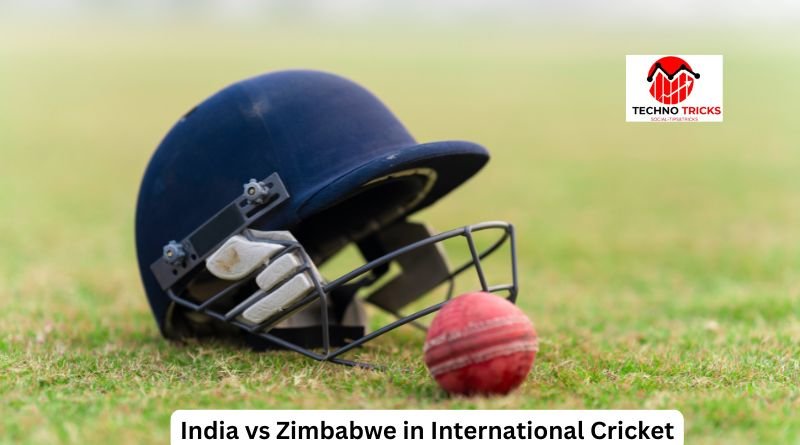A Historical Overview of India vs Zimbabwe in International Cricket
by Admin · September 27, 2024
Cricket has fostered some of the most captivating rivalries between nations, and while Zimbabwe and India may not be the fiercest cricketing opponents, their encounters have still provided some remarkable moments over the decades. Zimbabwe’s entry into international cricket came later than most, but their ability to challenge cricketing giants such as India has made for some memorable matches. This article outlines the historical timeline of matches between the Zimbabwe national cricket team and the India national cricket team, exploring early encounters, iconic games, and how the rivalry has evolved.
Zimbabwe’s Introduction to International Cricket and Early Encounters with India
Zimbabwe entered the international cricket scene in 1983, earning associate member status from the International Cricket Council (ICC). Their debut at the One Day International (ODI) level came during the 1983 World Cup in England. Though the cricketing world did not expect much from them, Zimbabwe stunned everyone by defeating Australia in their very first World Cup match. However, their next game against India in that same tournament marked the first official contest between the two nations.
The first ODI between India and Zimbabwe took place on June 11, 1983, at Tunbridge Wells, England. Zimbabwe’s efforts to gain momentum after their historic win against Australia were thwarted by India, who triumphed by five wickets. This match is best remembered for Kapil Dev’s legendary innings of 175*, which single-handedly pulled India from a dire situation. India had been reduced to 17 for 5 at one point, but Kapil’s counter-attack not only saved India from an embarrassing defeat but also remains one of the greatest innings in ODI history.
Zimbabwe’s Test Journey and Struggles Against India
Zimbabwe was granted full Test status by the ICC in 1992, making them the ninth Test-playing nation. India and Zimbabwe’s first Test match occurred in 1993 at the Harare Sports Club. While Zimbabwe was still finding its footing in the Test format, India’s experience and superior skill set made it difficult for Zimbabwe to compete at this level. The first Test match between the two nations ended in a draw, but the significance of this encounter was important for Zimbabwe, as they managed to hold their ground against an Indian team filled with stars.
Throughout the 1990s and early 2000s, India largely dominated Zimbabwe in Test cricket. Zimbabwe’s batting line-up, led by players like Andy Flower, Grant Flower, and Alistair Campbell, occasionally produced resilient performances, but they rarely matched India’s depth in both batting and bowling. Indian players like Sachin Tendulkar, Rahul Dravid, and Anil Kumble consistently outperformed their Zimbabwean counterparts. One of Zimbabwe’s rare moments of success in Test cricket came in 2001, when they managed to secure a draw against India at home, showcasing their potential to challenge stronger teams on certain occasions.
Zimbabwe’s Upsets and ODI Victories
While India generally dominated the Test format, Zimbabwe had more success in One Day Internationals. The ODI format has seen more competitive matches between the two sides, with Zimbabwe pulling off notable victories despite India’s overall dominance in the rivalry. One of Zimbabwe’s most famous victories came during the 1997 Independence Cup, held in India. In this triangular series, Zimbabwe successfully chased down a target of 276, thanks to a stunning century by Grant Flower. Defeating India in their home conditions was a major achievement for Zimbabwe and boosted their confidence in the ODI format.
Another remarkable moment came during the 1999 Cricket World Cup, where Zimbabwe stunned India with a narrow three-run victory in a thrilling contest. Batting first, Zimbabwe posted 252 on the scoreboard, a competitive total that tested India’s batting depth. Rahul Dravid’s century brought India close to victory, but Zimbabwe’s bowlers held their nerve in the final overs, securing a dramatic win. This victory was crucial for Zimbabwe’s campaign, helping them advance to the Super Six stage of the World Cup.
Despite these upsets, India continued to win the majority of their encounters against Zimbabwe in ODIs. In later years, as Zimbabwe’s cricketing infrastructure declined due to various internal issues, India’s dominance in ODI series became even more apparent.
The Emergence of T20Is and Zimbabwe’s Struggles
With the advent of Twenty20 International (T20I) cricket, the dynamics of the rivalry between India and Zimbabwe shifted. The shortest format of the game has seen fewer encounters between these two teams, but India has largely outclassed Zimbabwe in T20Is. Zimbabwe’s limited pool of T20 specialists has often struggled against India’s experienced and versatile lineup, packed with power hitters and skilled bowlers.
A significant moment in their T20I history occurred in 2016, when India, fielding a second-string team, toured Zimbabwe for a series of both ODIs and T20Is. India comfortably won the ODI series but faced tougher competition in the T20I series, where Zimbabwe managed to win one match. Despite this brief moment of success, Zimbabwe has been unable to consistently challenge India in this format, as India’s T20 experience and depth have proven too overwhelming.
Individual Brilliance: Key Players from India and Zimbabwe
The history of matches between Zimbabwe and India has featured outstanding individual performances that have defined some of their most memorable encounters. Kapil Dev’s unbeaten 175* against Zimbabwe in the 1983 World Cup remains one of the most iconic innings in cricket history. His counter-attacking knock not only saved India from elimination in the tournament but also set the tone for India’s eventual World Cup triumph.
Zimbabwe, too, has produced its share of outstanding performers in their matches against India. Andy Flower, arguably Zimbabwe’s greatest cricketer, consistently performed well against India. His ability to play spin bowling with ease made him a thorn in the side of India’s bowling attack during the late 1990s and early 2000s. His brother, Grant Flower, also left his mark on the rivalry with his century in the 1997 Independence Cup, a match that remains one of Zimbabwe’s most significant victories against India.
Heath Streak, Zimbabwe’s legendary fast bowler, often led Zimbabwe’s bowling attack with distinction. His accuracy and ability to swing the ball both ways made him a difficult bowler for Indian batsmen to handle, even on flat subcontinental pitches. More recently, players like Brendan Taylor and Sikandar Raza have shown flashes of brilliance, particularly in ODI cricket. Brendan Taylor’s century against India during the 2015 World Cup was a reminder of Zimbabwe’s fighting spirit, although it came in a losing cause.
Recent Encounters and Zimbabwe’s Decline
The last decade has seen a significant decline in Zimbabwean cricket, both on and off the field. Administrative challenges, lack of funding, and an exodus of talent have all contributed to the weakening of Zimbabwe’s cricketing structure. As a result, the contests between India and Zimbabwe have become increasingly one-sided, with India winning most of the bilateral series comprehensively.
India’s 2016 tour of Zimbabwe, where they sent a team composed mainly of young, inexperienced players, was indicative of the growing disparity between the two nations. India’s second-string team comfortably won both the ODI and T20I series, showcasing India’s depth in talent. Zimbabwe, while competitive at times, struggled to mount a serious challenge, reflecting their declining status in world cricket.
Looking Ahead: The Future of the Rivalry
The India vs Zimbabwe rivalry, though not one of cricket’s fiercest, has produced some memorable moments over the years. However, the future of this rivalry depends largely on Zimbabwe’s ability to rebuild its cricketing infrastructure and regain its competitive edge. India, on the other hand, continues to grow stronger, with a deep talent pool and a thriving domestic structure that has produced world-class players across all formats of the game.
While India is expected to continue dominating Zimbabwe in upcoming encounters, cricket’s unpredictable nature means that Zimbabwe could always spring a surprise. For fans of the game, the hope is that Zimbabwe can regain their former strength and once again challenge stronger teams like India on a regular basis.
Conclusion
The historical timeline of matches between the Zimbabwe national cricket team and the India national cricket team showcases how the two sides have evolved over the years. While India has emerged as one of the dominant forces in world cricket, Zimbabwe has had its share of memorable victories, particularly in the ODI format. As Zimbabwe seeks to rebuild its cricketing fortunes, future encounters with India will serve as opportunities for the African nation to once again challenge one of the world’s cricketing giants.
Read also: check




